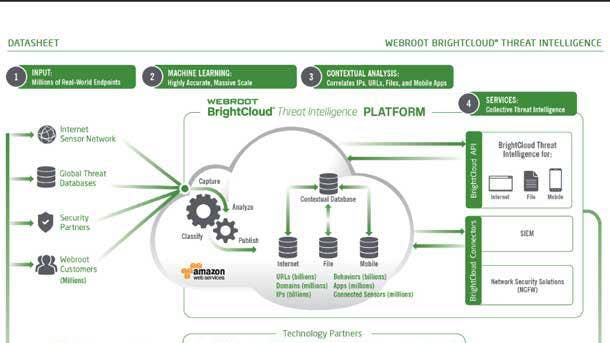6 Steps Carbonite And Webroot Have Taken To Come Together As One
From enabling partners the cross-sell the other organization's products to consolidating around a single back-end quoting and provisioning system, here are six key integration milestones for Carbonite and Webroot.

Elevating The Endpoint
Carbonite and Webroot are forging ahead as one organization focused on providing resilience around the endpoint through upfront protection and robust backup and disaster recovery. Even though Carbonite's $621.7 million acquisition of Webroot closed on March. 26, the integration process is still very much underway across both the technical and sales organizations.
Playing an integral role in unifying the Carbonite and Webroot go-to-market motions is Craig Stilwell, who joined Carbonite in July as chief revenue officer following nearly three years leading global partner sales at Citrix. Stilwell told CRN he's spent his first two months on the job getting the lay of the land and figuring out how the company can be easier to do business with.
Webroot MSPs using a different data protection product today will need to consider if it's worth the significant time and cost investment to move their customers over to Carbonite's backup and disaster recovery tools, said Bill Augustine, president and CEO of Cincinnati-based Augustine Consulting.
Given the intensive process involved in conducting due diligence on the Carbonite product and potentially swapping the existing data protection software out, Augustine said the channel community will need to be educated on the features Carbonite offers that make further investment worthwhile for partners.
From enabling partners to cross-sell the other organization's products to training the sales team on the entire technology stack to consolidating around a single back-end quoting and provisioning system, here are six key milestones Stilwell has identified in the process of integrating the Carbonite and Webroot businesses together.

6. Examine Future Of Webroot Brand
Carbonite has contracted with an outside agency to work through how the company is going to brand its products that span the gamut from endpoint protection and security awareness training to server backup and disaster recovery as a service.
The company is considering a variety of options, Stilwell said, including having separate brands for its consumer and SMB divisions, maintaining separate brands for different technology areas (akin to what exists now, with data protection products going to market under the Carbonite brand and cybersecurity products under the Webroot brand), or adopting a single brand for the entire product suite.
If unifying under a single brand, Stilwell said the company will need to consider whether it wishes to carry the Carbonite or Webroot brand forward or adopt a new moniker altogether. And from an events standpoint, Stilwell said the company will need to decide whether to have separate gathering for reseller and MSP partners or to bring everyone together to one place.

5. Assemble Leadership Team Through CEO Transition
The fingerprints of former Carbonite CEO Mohamad Ali remain all over the business thanks to his ability to bring a lot of companies into the fold despite Ali stepping down on July 25 to take the CEO role at IDG, Stilwell said. Following in Ali's footsteps on an interim basis has been Steve Munford (pictured), chairman of Carbonite's board of directors and the former CEO of both Sophos and Absolute Software.
Over the past two months, Stilwell said Munford has gone well beyond just leading the search for a permanent CEO to ensure that the combined organization moves forward faster. Specifically, Stilwell praised Munford for tapping into both legacy Carbonite and legacy Webroot to create a joint executive leadership team that brings together the perfect mix of expertise, personality, and culture.
Having the rest of the joint leadership team in place will help through the move to a new, permanent CEO, Stilwell said. Both Munford and the board want to ensure Carbonite and its partners enjoy a smooth transition when its new leader is named, according to Stilwell.

4. Train The Sales Team On The Whole Technology Stack
Although the combined company will have some specialists that are deep in a particular technology area, Stilwell said the expectation is that the legacy Carbonite and legacy Webroot sales teams will become fluent in the entire combined product offering.
The effort to get everyone comfortable with representing the entire suite has manifested has been a major point of emphasis at sales kickoff meetings for both the legacy Carbonite and legacy Webroot organizations, Stilwell said. The company brought in product marketing experts from the other side of the organization to get the respective sales teams trained up on the new technology, Stilwell said.
Stilwell doesn't believe Webroot and Carbonite's legacy product sets are all that disparate since businesses are ultimately looking to resiliency across their endpoints, whether that's in the form of upfront protection or backup and disaster recovery. Fusing the protection and backup pieces together is vital in thwarting emerging threats like ransomware, Stilwell said.

3. Unifying Quoting, Order Processing On A Single System
The biggest obstacle in streamlining the provisioning partners for partners who are looking to purchase data protection tools from the legacy Carbonite side and cybersecurity technology from the legacy Webroot side is the continued use of separate order processing and back-end systems, Stilwell said.
For now, the company is passing leads into each other's system, Stilwell said, with a Carbonite sales rep passing the order info to a Webroot sales rep or vice versa. The process today requires a lot of hand-holding and is pretty resource intensive from a human capital standpoint, but Stilwell expects the quoting and delivery systems to be integrated by the time the company is cross-selling at scale.
The company is working to develop a consistent, repeatable way to get quotes in the customer's hand and get products delivered regardless of which side of the business they're coming from, according to Stilwell. The company expects to deliver a seamless experience for different product lines in the same system and make it possible for partners to get product deliveries in the same system in the first quarter of 2020.

2. Organize Channel Team By Go-To-Market Motion
The company plans to eschew lining its channel team up by product and instead organize its channel teams across three different go-to-market motions, Stilwell said: MSP, resale, and SMB. The legacy Carbonite organization worked with its partners and customers in different ways, and relied on passing leads for very small organizations such as a five-person dentist office, Stilwell said.
As Carbonite moved up the pyramid size-wise, Stilwell said the company would then turn to more of a co-selling model. Going forward, Stilwell said the company wants to invest in a co-sell model where the vendor is bringing more leads to the resell partners regardless of the size of the organization.
As the integration evolves, Stilwell said Carbonite wants to put more of a focus on its higher-level partners and support the more sophisticated motion needed to service larger customers. The company additionally wants to take advantage of the strengths each organization is bringing to the table such as the legacy Carbonite e-commerce resale engine, according to Stilwell.

1. Begin Cross-Selling Products Across The Entire Customer Base
The company has over the past few weeks begun testing its ability to sell Webroot cybersecurity products through traditional Carbonite channels and vice versa, Stilwell said. The cross-selling trial began in the consumer space – where more than 900 Carbonite data protection sales occurring into Webroot customers, or vice versa – and was extended into the mid-market space last week, he said.
Carbonite has thus far hand-picked partners to cross-sell the other organization's products, Stilwell said, and has already in just a week built a nice pipeline and closed a few deals on the business-to-business side of the house. The company hasn't yet done much marketing or enablement around the cross-sell opportunity, Stilwell said, but has sought to lower the barriers to entry for partners wherever possible.
The company plans to branch out to additional partners and make cross-selling available to them as well as soon as the collateral is ready to go, Stilwell said. Thus far, Stilwell said the cross-selling initiative has focused on dozens of top-tier channel partners out of the roughly 20,000 supported by the legacy Carbonite and Webroot organizations.